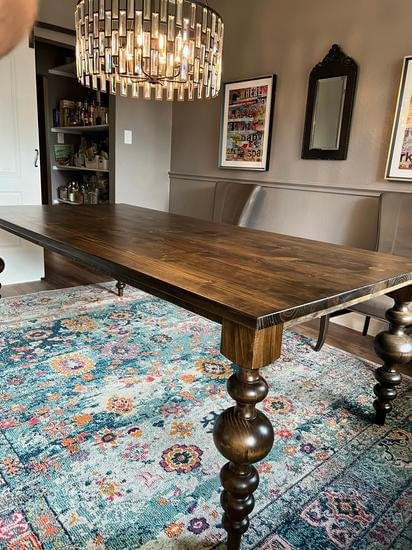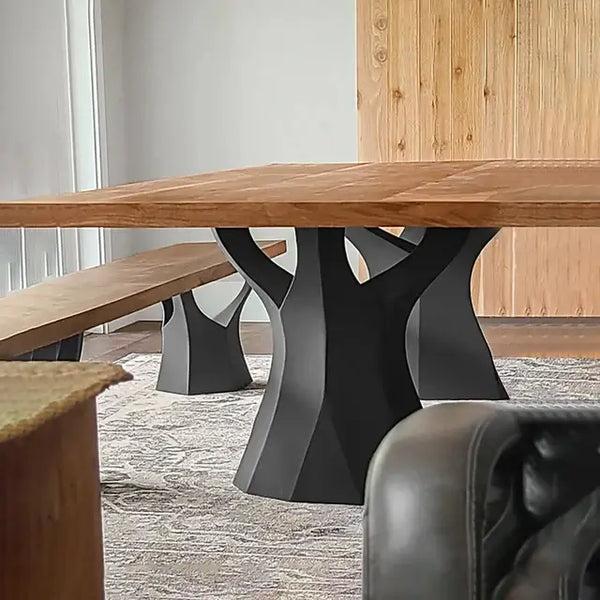How to Choose the Perfect Dining-room Table Legs for Your Home Decoration
Selecting the ideal eating space table legs is a nuanced process that calls for mindful consideration of various aspects, including your room restraints, visual choices, and sensible needs. The interplay in between styles, measurements, and materials can dramatically influence the ambiance of your dining location, making it important to approach this choice systematically.
Assess Your Eating Area
Analyzing your eating room is critical for picking the right table legs that complement both aesthetics and performance. Begin by gauging the measurements of your eating area, consisting of ceiling elevation, flooring area, and closeness to other furniture. This details will aid determine the appropriate size and elevation of your table, which straight influences the option of table legs.
Next, think about the style and layout of your dining space. An open-concept style might benefit from table legs that provide visual lightness, such as slender metal or acrylic alternatives. Conversely, an extra conventional setting could require sturdy wooden legs that offer a sense of durability.
Evaluate the existing shade combination and materials in your eating location. Balancing the table legs with these elements develops a natural appearance that improves the general decor.
Ultimately, a thorough evaluation of your eating space will certainly direct you in making an informed choice, making certain that your table legs not just boost the visual charm but additionally serve functional objectives.
Consider Your Style Preferences
When selecting dining space table legs, it is important to review your personal style preferences, as they substantially affect the overall visual of your dining space. Your choice of table legs can either enhance or comparison with existing decor, making it vital to straighten them with your favored interior decoration style.
If your home leans in the direction of a modern-day visual, consider smooth steel or minimalist wooden legs that give a clean, clean look. For a more conventional method, ornate wooden legs with complex makings can add a touch of sophistication and refinement. Industrial styles profit from durable, basic materials such as redeemed wood and steel combinations, reflecting a sturdy charm.
In addition, farmhouse and rustic designs commonly prefer sturdy, beefy legs that evoke a sense of heat and convenience. On the other hand, if your decoration is eclectic, you could select unique shapes or a mix of products to develop visual rate of interest.

Evaluate Product Options
The selection of material for eating room table legs plays a pivotal role in both toughness and visual charm. Typical materials include wood, metal, and composite choices, each offering distinctive features that can influence the total appearance and long life of your table.
Timber is a traditional selection, recognized for its warmth and adaptability. Hardwoods like oak and walnut give remarkable strength and can be finished in various stains to match any decoration. Softwoods like want are much more prone to scratches and dents, making them less perfect for high-traffic locations.
Steel legs, commonly crafted from steel or aluminum, exude modernity and industrial charm. They are very durable and immune to put on, making them suitable for family members with youngsters or regular gatherings (dining room table legs). Additionally, steel can be ended up in numerous shades, boosting the personalization possibilities
Composite products, such as MDF or laminate, offer cost and varied styles. While normally less long lasting than solid timber or metal, they can still supply a fashionable appearance and are usually easy to preserve.
Eventually, the material you select must straighten with your lifestyle, aesthetic preferences, and the level of use your table will experience.
Determine Elevation and Dimension
Selecting the suitable height and size for your dining space table is important for both functionality and comfort. The typical height for dining tables normally varies from 28 to 30 inches, enabling enough legroom for most individuals when seated. It is crucial to consider the dimensions of your dining area and the types of chairs you intend to use.

Additionally, think about the proportions of your dining-room. A bigger table in a large area can produce a grand atmosphere, while a smaller sized table works well in even more intimate settings. Eventually, the right elevation and size will balance with your general style and enhance the dining experience for you and your guests.
Explore Customization Possibilities

In addition, the design of the legs can be tailored to fit look these up different styles, such as rustic, modern, or commercial. Conical legs can evoke a mid-century modern-day feel, while chunky, block-style legs might reverberate with typical or farmhouse style.
Home owners can likewise check out color finishes, from all-natural wood discolorations to paint, enabling them to match or comparison with the table top and surrounding decoration.
Additionally, leg elevation can be adapted to accommodate particular seating setups or personal choices, improving both convenience and performance.
Finally, web unique embellishments, such as carvings or ornamental braces, can additionally individualize the table legs, making the eating experience not just a declaration yet a dish piece in the home. By considering these customization options, homeowners can produce a dining-room table that really mirrors their uniqueness.
Final Thought
Choosing the optimal dining-room table legs needs mindful consideration of different variables, including the measurements of the eating room, design choices, product sturdiness, and preferred elevation. Personalization choices even more improve the ability to achieve a cohesive visual that enhances the overall decor. By systematically examining these aspects, home owners can make sure that the selected table legs not just accomplish useful needs but additionally contribute favorably to the eating experience and ambiance of the home.
Picking the optimal eating space table legs is visit a nuanced procedure that needs mindful factor to consider of numerous elements, including your space constraints, visual preferences, and sensible requirements.Evaluating your eating space is important for picking the right table legs that match both looks and capability.When establishing dimension, measure the area where the table will certainly be positioned to guarantee it fits easily, allowing for at least 36 inches of clearance around the table for simple activity. A larger table in a spacious location can create a grand atmosphere, while a smaller table works well in even more intimate settings.Picking the ideal dining room table legs requires careful consideration of numerous variables, including the measurements of the eating area, style preferences, product toughness, and preferred height.